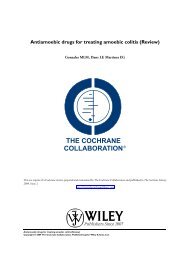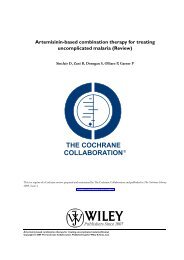Legislative smoking bans for reducing secondhand smoke exposure ...
Legislative smoking bans for reducing secondhand smoke exposure ...
Legislative smoking bans for reducing secondhand smoke exposure ...
Create successful ePaper yourself
Turn your PDF publications into a flip-book with our unique Google optimized e-Paper software.
Pell 2008 (Continued)<br />
Outcomes Self-reported <strong>exposure</strong> to SHS as defined by the number of hrs per wk in the home, work, “bars, pubs or clubs”,<br />
“cars, buses or trains”, other public places, other people’s homes and “all locations”.<br />
Number of hospital admissions and relative risk reduction (95% CI) of acute coronary syndrome (ACS) by age,<br />
gender and <strong>smoking</strong> status. Analysis of ACS in men 55 yrs, in women < 65 yrs and > 65 yrs and <strong>for</strong><br />
all patients with ACS. Acute coronary syndrome (ICD-10) defined by a detectable level of cardiac troponin after<br />
emergency admission <strong>for</strong> chest pain.<br />
Self-reported <strong>smoking</strong> status<br />
Biochemical verification: Yes; <strong>smoking</strong> status and <strong>exposure</strong> to SHS as measured by geometric mean serum cotinine<br />
ng/ml.<br />
Notes Non<strong>smoke</strong>rs defined as those with 12ng/ml serum cotinine or less. Limit of detection 0.1ng/ml.<br />
Pell 2009<br />
Methods Country: Scotland<br />
Setting: Scottish Acute Hospital Population<br />
Design: Pre and post-ban tests. Prospective cohort study. Data was collected pre and post ban in Scotlandon consecutive<br />
patients who were non <strong>smoke</strong>rs admitted with ACS to nine Scottish acute hospitals. Follow-up data were<br />
obtained from routine hospital admissions and death databases. Chi 2 tests <strong>for</strong> trend and logistic regression, both<br />
univariate and multivariate.<br />
Participants Consecutive admissions who were non <strong>smoke</strong>rs admitted with ACS to nine Scottish acute hospitals from May 2005<br />
to March 2007<br />
Baseline:1261<br />
Follow up: 30 days post admission<br />
50 had died and 35 had a non fatal MI.<br />
Interventions Smokefree legislation (Smoking, Health and Social Care (Scotland) Bill) implemented on 26 th March, 2006 prohibiting<br />
<strong>smoking</strong> in indoor workplaces, including bars, restaurants and cafes.<br />
Outcomes Cotinine levels. All cause death, cardiovascular death or readmission <strong>for</strong> a principal diagnosis of AMI.<br />
Biochemical verification: Yes. Urinary cotinine measured <strong>exposure</strong> to SHS.<br />
Notes<br />
Sargent 2004<br />
Methods Country: USA<br />
Setting: Helena, Montana<br />
Design: Observational study, cross-sectional surveys, pre and post-ban tests. Analysis: Analysis of admission admitted<br />
<strong>for</strong> AMI <strong>for</strong> people living in and outside Helenausing Poisson analysis.<br />
Participants Total sample: 304 admissions living in and outside Helena<br />
During ban period: 42 admissions<br />
Interventions Local law in place in Helena, Montana from June-Nov 2002 which banned <strong>smoking</strong> in workplaces and public places.<br />
<strong>Legislative</strong> <strong>smoking</strong> <strong>bans</strong> <strong>for</strong> <strong>reducing</strong> <strong>secondhand</strong> <strong>smoke</strong> <strong>exposure</strong>, <strong>smoking</strong> prevalence and tobacco consumption (Review)<br />
Copyright © 2010 The Cochrane Collaboration. Published by John Wiley & Sons, Ltd.<br />
48








